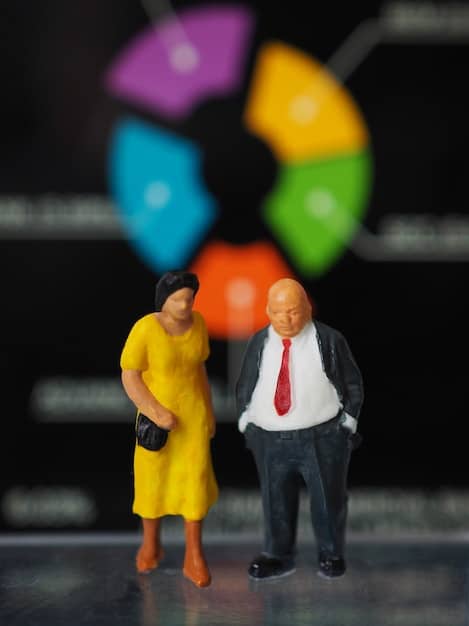New Designated Player Rule: How MLS Teams Will Spend in 2025

The new Designated Player (DP) rule in MLS is anticipated to significantly alter team spending strategies in 2025, potentially leading to more balanced rosters, increased investment in young talent, and a more competitive league overall as teams adapt to the updated financial landscape.
The landscape of Major League Soccer (MLS) is ever-evolving, and the How Will the New Designated Player Rule Impact MLS Team Spending in 2025? promises to be a game-changer for the league, one which reshape the way teams approach roster construction and financial strategy. This shift could ripple throughout the league, impacting everything from player acquisitions to youth development.
Understanding the Designated Player Rule
The Designated Player Rule, often referred to as the “Beckham Rule,” has been pivotal in shaping the competitive and commercial landscape of MLS since its inception. It was initially introduced to allow MLS teams to sign high-profile players who would otherwise exceed the league’s salary cap.
The original intent
The rule was designed to attract star players to MLS, boosting the league’s popularity and competitiveness on the global stage. David Beckham’s arrival in 2007 under the DP rule marked a turning point for MLS.
Evolution over the years
Over the years, the Designated Player Rule has been tweaked and adjusted to address various issues and to promote more balanced roster construction. These changes aimed to distribute talent more evenly across the league.

Here are some key adjustments of the rule:
- Introduction of Targeted Allocation Money (TAM) to help teams sign players who are below DP level, bridging the gap between DPs and regular players.
- Limitations on the number of DPs a team can have, promoting a more balanced investment in the overall squad.
- Rules regarding how DP salaries count against the salary cap, influencing how teams structure contracts.
In conclusion, understanding the historical context and evolution of the DP rule is crucial for grasping how the new changes will impact team spending and roster construction in MLS in 2025.
Key Changes to the DP Rule in 2025
The adjustments to the Designated Player Rule in 2025 are aimed at fostering greater financial flexibility within MLS teams, promoting investment in player development and creating a more level playing field across the league.
Increased flexibility
One of the key changes is an increase in the amount of allocation money available to teams, providing more resources to manage their rosters effectively and strategically. This flexibility can enable teams to make tactical acquisitions.
Emphasis on young talent
There is a growing emphasis on encouraging teams to invest in young, developing players. The new rule may include incentives for signing U-22 players, allowing teams to secure promising talent without significant salary cap implications.

Here’s how teams are expected to adapt to the rule changes:
- Strategic use of allocation money to bolster different areas of the squad.
- Increased scouting efforts to identify and secure young, high-potential players.
- Balancing DP investments with the need for depth and quality across the entire roster.
In summary, the key changes to the DP rule in 2025 are designed to give teams more flexibility, encourage investment in youth, and promote a more balanced approach to roster construction, ultimately improving the competitiveness of MLS.
Potential Impact on Team Spending
The new Designated Player Rule is poised to significantly impact how MLS teams allocate their financial resources. These changes are expected to drive more strategic spending and promote greater parity among teams.
Shifting priorities
Teams may shift their priorities away from solely focusing on high-priced DPs and towards investing in a broader range of talent, including young players and quality squad players. The need of a balanced roster is key.
Strategic allocation
The increase in allocation money will enable teams to make strategic acquisitions and fill crucial gaps in their rosters, improving overall squad depth and competitiveness, which promotes strategic play.
Here are some potential ripple effects of the new rule:
- A decrease in the reliance on aging superstar DPs, with teams opting for younger, more dynamic players.
- An increase in the number of international signings of players in the TAM range, enhancing the quality of the league.
- More investment in academy systems and youth development, fostering a sustainable pipeline of talent for MLS teams.
In conclusion, the new DP rule is likely to lead to more balanced and strategic spending by MLS teams, promoting a more competitive environment and fostering long-term growth and sustainability.
Strategies for Maximizing the New DP Rule
To maximize the benefits of the new Designated Player Rule, MLS teams will need to adopt innovative strategies that leverage the increased flexibility and incentives for youth investment. Teams has to know to maximize profits.
Youth development
Teams should prioritize investment in their academy systems and youth development programs, creating a pipeline of talented young players who can contribute to the first team, wich reduces external costs.
Scouting networks
Expanding scouting networks, both domestically and internationally, will be crucial for identifying and acquiring high-potential players who fit the team’s playing style and needs, so you have a backup plan.
Some strategies that will help to maximize profits:
- Building strong relationships with international clubs and academies to facilitate the acquisition of young talent.
- Utilizing data analytics to identify undervalued players who can provide significant value at a reasonable cost.
- Adopting a flexible and adaptable approach to roster construction, being willing to make changes based on performance and market conditions.
In conclusion, maximizing the new DP rule requires a holistic approach that combines investment in youth, strategic scouting, data-driven decision-making, and financial acumen, setting the stage for long-term success in MLS.
MLS Team Spending in 2025: Predictions
Looking ahead to 2025, several key trends are likely to emerge in MLS team spending patterns as teams adapt to the new Designated Player Rule, and trends that lead to success.
More youth investment
Expect to see increased investment in young, developing players, both from domestic academies and international markets. The youth is what move the world.
Balanced rosters
Team spending will become more balanced, with a greater emphasis on building deep and versatile squads, rather than relying solely on a few high-priced stars. The importance of this balance is key.
Predictions:
- A rise in the number of MLS teams adopting a “Moneyball” approach, using data analytics to identify undervalued players.
- Increased competition for young talent, both domestically and internationally, driving up acquisition costs.
- More strategic use of allocation money to fill crucial gaps in rosters and improve overall squad depth.
In summary, predictions for MLS team spending in 2025 point to a shift towards more balanced rosters, increased investment in youth, and a greater emphasis on data-driven decision-making, shaping the competitive landscape of the league.
Long-Term Effects of the New DP Rule
The long-term effects of the new Designated Player Rule are far-reaching, with the potential to transform the competitive balance, financial sustainability, and overall quality of Major League Soccer.
More competition
A more level playing field will foster greater competition among teams, making MLS more exciting and unpredictable for fans. If some teams are better than other, this is not going to be well for the team.
Financial sustainability
Encouraging teams to invest in youth and build balanced rosters can promote long-term financial sustainability, reducing the reliance on expensive, aging stars. More investment in youth brings financial returns.
Long-term effects of the new DP rule:
- A more diverse and dynamic player pool, with contributions from players across different age groups and nationalities.
- An increase in the number of MLS teams competing for championships, creating a more unpredictable and exciting league.
- A stronger connection between MLS academies and first teams, fostering a sustainable pipeline of talent for the league.
In conclusion, the long-term effects of the new DP rule are poised to elevate MLS to new heights, fostering greater competition, financial sustainability, and overall quality, making the league a more attractive destination for players and fans alike.
| Key Point | Brief Description |
|---|---|
| 💰 Increased Flexibility | Teams get more allocation money for strategic acquisitions. |
| 🌱 Emphasis on Youth | Incentives for signing U-22 players, focusing on young talent. |
| ⚖️ Balanced Rosters | Teams shift to building deeper squads, not just star players. |
| 📈 Strategic Spending | More focus on data analytics and undervalued players. |
Frequently Asked Questions
▼
The Designated Player Rule, or “Beckham Rule,” allows MLS teams to sign players whose salaries exceed the league’s salary cap, designed to attract high-profile talent and boost league popularity.
▼
In 2025, the DP Rule is expected to bring increased allocation money, incentives for signing U-22 players, and a greater emphasis on balanced roster construction for MLS teams.
▼
These changes aim to promote financial flexibility, encourage investment in young talent, and create a more level playing field, enhancing competition and long-term sustainability in MLS.
▼
Teams can maximize the new DP Rule by investing in youth academies, expanding scouting networks, and using data analytics to identify undervalued players, enhancing their roster.
▼
The long-term effects include greater competition, improved financial sustainability, and a stronger connection between MLS academies and first teams, elevating the league’s overall quality.
Conclusion
In conclusion, the new Designated Player Rule is set to reshape MLS team spending in 2025, fostering balanced rosters, youth investment, and strategic financial planning. This evolution promises a more competitive and sustainable league for both players and fans.





